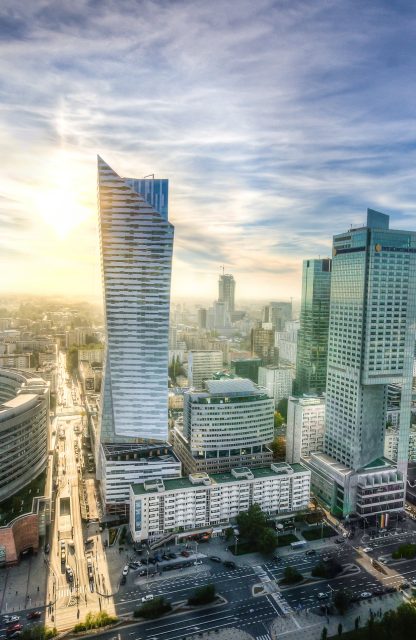Which industry will win the investment race this year? Will the investors who look for a bargain on the Polish market continue to focus on office buildings as they did last year? Or will the investment transaction market be dominated by warehouses and retail parks?
The ongoing changes in the global economy haven’t materially affected the decisions of investment funds and their perception of Poland as an attractive investment spot. Even though the investors are more cautious in their deal-making decisions, on the domestic market the year 2022 ended with a similar investment volume in the commercial property sector as the year before. That was the case for the entire CEE region. With its major share in the total investment volume in the region, Poland has maintained its leading position in the CEE.
Warehouses overthrown
The assets that most frequently changed their owners in the past year are office properties which managed to overthrow the logistics sector from its leading position that it had occupied two years in a row. In 2022, the total investment volume in Poland amounted to over EUR 5.8bn, with the warehouse deals constituting one third of that value. The deals involving logistics properties totalled to EUR 2 billion and ranked second in terms of value, right after offices. In 2022, the investors’ activity in the warehouse sector dropped by over 30 percent year on year, while the commercial properties market recorded its best results in years.
The deal volume was way beyond the one documented in the previous year. The acquisitions in the commercial sector on the Polish market totalled to EUR 1.5bn in 2022. The majority of transactions involved small-scale retail parks and convenience stores, but several large commercial centres in the major Polish cities changes their owners, too.
Detailed asset value analysis and waiting for a bargain
Nowadays, the investors pay greater attention to the location of the properties and more closely look into the tenant structure. Particularly interesting are still the attractively located warehouses and retail parks, secured with beneficial lease contracts. The investor search also for plots for retail park development and residential properties for the PRS purposes. However, the negotiations processes are accompanied by an in-depth analysis to verify the investment value of the assets, as well as ESG-related matters. Another key element in the decision-making process in the quality and stability of lease contracts with tenants.
Poland continues to be an interesting market for investment funds, particularly from the US, Germany and South Africa, yet capital of the CEE-origin begins to play an increasing important role, too. Still, certain slowdown is expected to be visible on the investment market this year, as the buyers anticipate price discounts. In a number of cases, there is a significant discrepancy between buyers and seller as to the estimated property value. What additionally hinders a successful deal-making is also high borrowing costs for the investments, rigid conditions for granting loans, as well as the expected global recession. All these are accompanied by surging energy prices and increasing more demanding EU climate policies.
Borrowing costs vs yields
Unfavourable economic climate, inflation, growing maintenance expenses, and high costs of financing investments have resulted in an adjustment in asset prices on all European markets, which in Poland continues to be less severe that in the Western Europe. The slowdown on the investment deals market is becoming more visible across all European states. This is hardly surprising, considering increased borrowing costs whose level is currently similar to the yields for the most attractive assets.
Yet, the situation could improve soon. Some significant increase in rents in the warehouse sector was observable already last year, both in Poland and on other European markets. Despite ongoing changes, the Polish market remains one of the least expensive in Europe. Apart from the lower lease rents, the country offers also highly skilled staff, lower operating costs, and convenient location in the vicinity of the outlets, which is particularly relevant in the context of nearshoring and transfer of the manufacturing processes from Asia. As per the latest Reuters report, in that respect Poland is the first choice for the European companies. It competes for manufacturing investments of the Asian origin with Czechia and Hungary. The time will tell how many projects that are currently being analysed will actually be moved to the country.
Warehouses under construction
Last year, the warehouse and commercial sectors were the fastest growing parts of the commercial property market in Poland. As a result of delivery of the largest volume of new space in the history of the Polish market, more than 28 million square meters were added to the domestic warehouse resources. The record-breaking supply is accompanied by a high demand. The contracts executed last year covered 6.8m square meters of warehousing space, which is just slightly below the record-breaking 2021.
The industrial and logistic properties in Poland continue to develop dynamically. And there is still a large potential for growth in the most valuable locations, such as the regions around Warsaw and Poznań, or in Silesia. A relatively large volume of space – 3.4m square meters – is currently under construction in Poland.
Yet, an incremental quarter-on-quarter drop in the number of the launched investments projects was observable last year. That resulted mainly from higher construction material prices and borrowing costs, as well as lower activity of investment funds. The adjustment in property value brought also a drop in new supply on the majority of European warehouse markets.
High demand for logistic facilities
The market forecasts indicate a further increase in the warehouse lease rents. Following the last year increase in rents, which went up on average by 20 percent, we continue to be a competitive market compared to the rest of Europe. The main driving force for the warehouse market are currently the logistic companies and manufacturers, as well as e-commerce, which is, however, developing slower than before.
The high demand for space results in a low vacancy rate in the industrial and logistic industries in the CEE market, which is on average below 5 percent. In the most popular locations, the demand for warehouses is often higher than the supply.
Deceleration of commercial project development
Higher liquidity on the investment market recorded in the Polish commercial property sector in 2022 could be suppressed this year by certain unfavourable economic developments and high project financing costs. Decreased dynamics in retail sales has been a threat to the sector, next to the higher maintenance costs of buildings.
This year, the lower pace for new project development is expected also on the commercial market. In 2022, as much as 350 thousand square meters of new space was added to the sector in Poland, and the majority of that volume was delivered in the cities over 100 thousand residents.
Some 300 thousand square meters of space for commercial purposes is currently under construction, even though the initial plans were significantly bolder. The vast majority is located in the retail parks under construction whose supply is expected to increase in the years to come.
The characteristic element of the domestic commercial market are the redevelopment projects of properties which used to be rented by Tesco and are on regular basis transformed into new commercial centres.
Ironically, the growing popularity of retail parks among both customers and investors is a result of a higher inflation rate and lower purchasing power of money. That is linked to the nature of such projects whose offer tend to include value retailers. Smaller, local commercial centres that facilitate convenient, daily shopping close to home become increasingly important year-on-year.
Retail parks are developed mainly in smaller towns with an existing supply gap. Their competitive advantages are lower investment costs and maintenance costs compared to large commercial centres. In the coming years, the market will continue to boost its investment potential and remain interesting for the investors.
Author: Agata Karolina Lasota, Managing Director at LBC Invest








